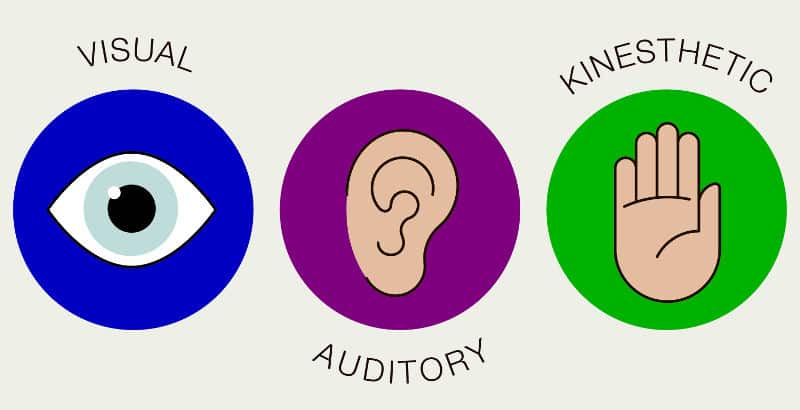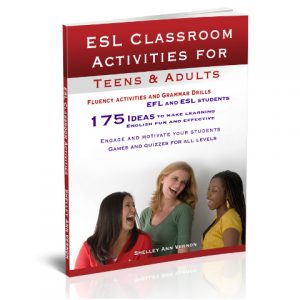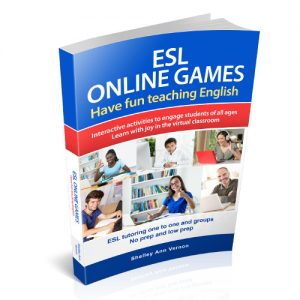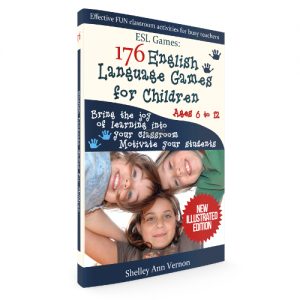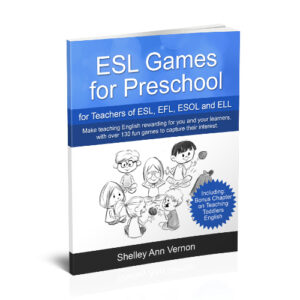Learning styles have been studied for decades, and there are several models that various researchers have proposed. While the finer distinctions are still debated, most authorities in the field generally agree upon four basic learning styles. These are auditory learners, visual learners, kinaesthetic learners, and tactile learners. However, there is a great deal of overlap between the kinaesthetic and tactile learning styles, and they will be treated together here.
As a teacher, what do learning styles mean for you? You come into class to teach a lesson on the simple present tense, or maybe it’s a vocabulary lesson or conversation practice. You follow your textbook and give great examples to illustrate your points and have plenty of practice worksheets. Unfortunately, no matter what you do, there are always two or three students who just don’t get it. What is going wrong? Why aren’t you getting through? The answer may well lie in your students’ learning styles.
First of all, you need to find your main teaching style. Then, whether you lecture or do role-plays or worksheets, you need to figure out your own style to supplement it to fit your students’ learning styles. So, of course, you need materials and activities to increase your range. In addition, you need flexibility, and ideally, you want to add some fun. That is where English games come in. Teaching with a variety of games will integrate different ways of learning automatically. And so, they are the perfect supplements to your usual teaching style.
Auditory Learners
Students who learn well from lectures, verbal explanations, recordings, and oral instruction are generally auditory learners. Language games for this type of learner are mainly listening-based. They include games that involve repetition, dictation and listening for clues.
Recitation games
These games involve students repeating language they have heard. Chinese Whispers, Jazz Chants, and Karaoke Night are good examples. Karaoke Night is a trendy game in Japan, where most students are familiar with the idea of singing for workmates. Therefore, it’s not unusual to have a student ask you for help with preparing a song in English for a business party.
If you teach more conservative adults, use a variation of Jazz Chants. For example, rehearse a short rhythmic dialogue with a metronome or hand clapping and emphasize the fluency practice. You might also teach a lesson on jazz history in America. That kind of lesson works very well in classes where students study English as a hobby or for travel.
Listening games
EFL Students studying English in their own country often express concern that they can understand their teacher but not other native speakers. To solve this limitation, listen to recordings or videos with short dialogues. Use listening games like Vocabulary Scavenger Hunt, which involves locating missing words on multiple recordings at different listening stations!
There are also Cloze Passages, where the students listen to a recording while reading a transcription. As they listen, they fill in any blanks. Jigsaw listening is also an excellent team-building game. Teams send representatives to different listening stations and then try to reconstruct the story when all the listeners have returned to the group. These games also help students learn how to use TV and radio broadcasts in English to listen independently.
Quiz and story building games
Quiz games like Jeopardy, grammar knockout type games, and listening memory games are great for any level of auditory learner. Their flexibility goes from basic questions like spelling and definitions to more challenging tasks like asking for a word to be used in a sentence, explaining a grammar rule, or cultural trivia.
Another set of games to teach auditory learners are story and sentence-building games. “Madlibs” is one such game that can be store-bought or homemade. To make it, students fill in words to make funny and nonsensical stories. These games require excellent listening and memory skills as they are challenging. In addition, they usually end with a verbal recap of the finished story or sentence, allowing students to check their understanding.
All these games are in my English Language Games Book for Teens and Adults, a gold mine of games and activities for teens and adults!
Visual Learners
Visual learners prefer to read silently and appreciate illustrations that go with the text. They will generally learn better with written instructions. These students also benefit from seeing you act a situation rather than explain it. They enjoy watching a demonstration or a scenario in a video. If you have a student who seems to retain what they read better than what they hear then that student is a visual learner. Many language games work with these students, and they help other types of learners too!
Board games
There are plenty of commercial board games, but you can also make your own. For example, “Folder games” involve making a game board, often based on a commercial one, and using it to practice grammar, vocabulary, phonics, and spelling. For a solid board, laminate a manila folder and staple a bag inside with the game pieces and cards. Examples are Grammatical Snakes and Ladders, Parts of Speech Path Finding (based on the Candy Land Board), and A Day in the Life (based on the game Life). In this game students participate in mini-role-plays via dice and scenario cards. Decorate the boards, but not childishly, since that will turn off your adult students, but they can still be colourful.
Picture games
These games include anything with pictures as their main starting point. Pictures can replace words in many games, such as Jeopardy. Another game that advanced students love is picture captioning or comic strip re-writes. If you use comics from abroad, you can get into sophisticated discussions about what constitutes humor in different cultures. Many students get to a certain level of advanced English and then plateau because they can’t get away from academic or basic survival situations. Therefore, studying humor through these visual games can help bridge that gap.
Reading games
Reading is an essential skill for all students and works well with visual learners. For example, the language game Reading Treasure Hunt, where students look for particular parts of speech or vocabulary, teaches skimming and reviews grammar and vocabulary. Ten Important Sentences with Watermelon, where teams send a representative to put sentences in order, helps with summarizing, working under pressure, and team-building. This game also suits tactile learners.
All these games are in the English Language Games Book for adults with 175 games and activities with printable appendix of ready-made accessories! However, if you are teaching online, then ESL Online Games is the book to go for.
Tactile and Kinesthetic Learners
Tactile and Kinaesthetic learners often don’t get what you’re teaching in a traditional lecture or worksheet-based lesson. These learners take in information best when they use their whole bodies to learn. For example, they are more likely to learn well from model building and hands-on tasks.
Interestingly, a study from the 1980s (Reid, 1987) found the self-reported preference among English Language Learners for language lessons was Tactile and Kinaesthetic by a wide margin. This goes to show how important it is to try and integrate more physical and experiential elements into our English lessons.
What makes a game kinaesthetic or tactile? Look for games involving whole-body responses, touching, and moving things around. Games with these elements associate physical activity and touch with specific meanings. There are three broad groups: Touch Games, Spatial Games, and Craft Games.
Touch Games
The most common games involving touch are those with real items. For example, students touch things inside a bag and guess them. The easiest version is a vocabulary game where students identify the objects. For a more advanced activity, the students describe what they feel, while the rest of the class guess what it is.
Spatial Games
These games involve rearranging items or people and can be kinaesthetic and tactile. They include traditional games like charades and others, like Population Punctuation, where each student has a card with words or punctuation on it. One person who is ‘it’ tries to arrange the people at the front of the class so that the cards make a correctly punctuated sentence using as many people as possible.
Craft Games
Any game where the students assemble something is great. For example, in Lego Negotiations, students negotiate with other teams for specific pieces to create their Lego creature according to their instructions. Do this with homemade tangrams if you don’t have any Lego. Map drawing is another good example, and it can also combine elements of auditory learning since the teacher will tell the students what to draw on their map.
Variety Brings Success
Language games are the easiest way to address different learning styles in the classroom. By putting students at ease, and stimulating their senses, you create a wealth of learning opportunities. These opportunities aren’t just for learning language, but also for broadening the students’ learning styles to include those that aren’t the first choice.
Will paying attention to learning styles solve all your classroom problems? No, of course not. But when you diversify your teaching style with games, you will reach more students more effectively than ever before. Games will cut down on boredom as student interest increases. Games will also allow students to diversify their own learning style. Students will be doing more than just expanding their English when they play games. They will be expanding their minds and the way they learn.
Great resources to stimulate all learning styles
-
Sale Product on sale
 Games and Activities for Teens and Adults
Games and Activities for Teens and Adults€19.97Original price was: €19.97.€15.33Current price is: €15.33.Rated 5.00 out of 5 based on 12 customer ratings -
 ESL Online Games€19.97Rated 5.00 out of 5 based on 4 customer ratings
ESL Online Games€19.97Rated 5.00 out of 5 based on 4 customer ratings -
Sale Product on sale
 ESL Games book for primary & middle school children
ESL Games book for primary & middle school children€19.97Original price was: €19.97.€15.33Current price is: €15.33.Rated 5.00 out of 5 based on 2 customer ratings -
Sale Product on sale
 Preschool games book
Preschool games book€19.97Original price was: €19.97.€11.97Current price is: €11.97.
All books are available in paperback too
If you would prefer a paperback then you will find all my books on Amazon, where you may also read hundreds of reviews from happy teachers. Here is my Amazon author page: Shelley Ann Vernon teaching resources
I’ll be here to help if you need me!
All the best, Shelley Ann Vernon
